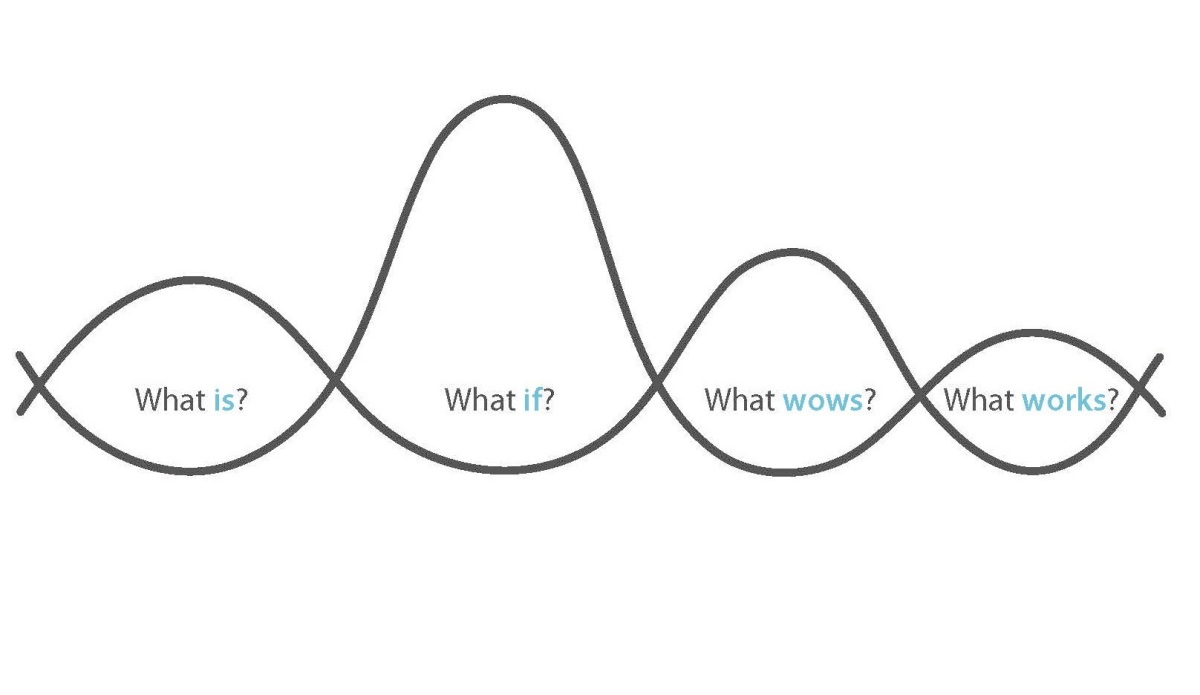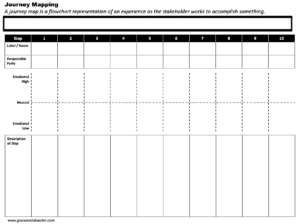
Design thinking is a human-centered, flexible approach to solving big problems. And Carol Hamilton, principal and founder of Grace Social Sector Consulting, uses her background in organization development combined with her expertise in design thinking, to help nonprofits and associations solve those big problems to become more strategic, effective, and innovative.
In this episode of the Leading Learning Podcast, Celisa talks with Carol about the topic of design thinking, including what it is and how it can be used in the context of a learning business (drawing on Jeanne Liedtka’s four-question formulation: what is, what if, what wows, and what works).
They also discuss areas adjacent to design thinking, such as journey mapping and innovation, as well as what could be considered the opposite of design thinking—the sunsetting of products and services.
To tune in, just click below. To make sure you catch all of the future episodes, be sure to subscribe by RSS, Apple Podcasts, Spotify, Stitcher Radio, iHeartRadio, PodBean, or any podcatcher service you may use (e.g., Overcast). And, if you like the podcast, be sure to give it a tweet!
Listen to the Show
Read the Show Notes
[00:18] – A preview of what will be covered in this episode where Celisa interviews Carol Hamilton, principal and founder of Grace Social Sector Consulting about design thinking.
Note that we devoted one of the four plenary sessions at Learning • Technology • Design 2020 to design thinking—Connie Malamed, who’s been a podcast guest before, led that session, and we also had a concurrent session led by Micène Fontaine that looks at design thinking and learning experience design.
If you didn’t register for LTD 2020 before the live sessions, we now have a way that you can get access to the recordings, as well as a much more. To find out details, go to leadinglearning.com/join.
Reflection Questions

[02:02] – You might consider the reflection questions below on your own after listening to an episode, and/or you might pull the team together, using part or all of the podcast episode for a group discussion.
- Listen to what Carol has to say about the importance of qualitative research to give you an experiential sense of what your learners are dealing with. Have you recently spent time interviewing, shadowing, or otherwise getting that qualitative view into the work, lives, and needs of your learners?
- Carol points out that design thinking itself is about small bets and getting into the methodology itself is best done through small bets. Is there a smallish, lower-risk project you can use to try out design thinking in your learning business?
[03:12] – Introduction to Carol and some additional information about her background and work.
What is Design Thinking?
[04:30] – I know design thinking is an area of focus for you. What drew you to design thinking, and what is design thinking?
Carol shares that she also has a background in organization development which is really about how people do work better together. And design thinking brought two things together for her—that focus on people and how they work together effectively—and also creating new and innovative things to solve problems and serve people better.
Another name for design thinking is human-centered design and it’s really that “human-centered” part that drew her to the methodology.
She describes design thinking as an approach for solving big, messy problems. But it’s not the best approach to use if there’s a known solution for a problem, if there’s more of an engineering kind of point of view to solve the problem, or if there aren’t people at the center.
It came out of the product development realm, but it’s applied widely now within non-profit organizations, learning organizations, international development, and more.
The core values that drive design thinking are:
- Putting people at the center
- Getting empathy for the people that you’re trying to serve and create something for
- Creating small bets
- Invention
- Iteration
Carol notes there are a lot of parallels between design thinking and strategic doing.
To learn more about strategic doing check out our episode, Strategic Doing with Ed Morrison.
Design Thinking in the Learning Business
[06:45] – Can you talk specifically about how design thinking might be used in a learning business? I’m thinking in particular about in the creation of new learning products and services.
Carol says that it’s very applicable and the area where she’s had the opportunity to use it. She talks about how she used it when working with an organization to help them reimagine how they might serve senior leaders within their field, which can be really challenging.
The process Carol likes to use (and is very accessible for folks who didn’t go to design school) is the one Jeanne Liedtka created from the University of Virginia’s Darden School of Business. It involves four-questions:
- What is? (Research phase)
- What if? (Brainstorming phase)
- What wows? (Testing your ideas)
- What works? (Testing your ideas)

The Importance of “What Is?”
[08:33] – Carol explains that too often, organizations jump immediately to the brainstorming process without taking the time to talk about what is the current situation.
This is beyond doing a typical needs assessment (which might be survey-driven)—it’s usually about taking more of a qualitative approach where you’re actually talking to people, interviewing, or maybe observing them.
Essentially, this helps to get more of an experiential sense of what’s going on. And she says this isn’t necessarily about asking people directly what they need, because that rarely gets you the information that you want. Rather it’s about trying to come at it more indirectly by asking them what’s going on in their situation/jobs—challenges, what’s going well, etc.
Then as you look across interviews, you start to see themes. You’re really looking for insights as to what those unmet needs are and what gaps they’re talking about that you can then design to.
Sponsor: Web Courseworks
[10:48] – If you have a gap or unmet need in your learning technologies or services, check out our sponsor for this quarter.
Web Courseworks is a leading learning technologies and consulting company that is forging a path of innovation in the eLearning industry. The company’s experiences and expertise guide its partners to become the leading providers of education in their fields. Web Courseworks channels organization learning efforts to deliver on the promise of revolutionary performance improvement.
CourseStage, the learning management system from Web Courseworks, is built for organizations and professional development initiatives. It enables organizations to customize learning experiences, track users’ success, and make data-driven decisions. CourseStage LMS is designed specifically to handle continuing education and professional development activities for organizations who want to grow their learning business.
Access a demonstration of the CourseStage LMS as well as other valuable Webinars from Web Courseworks at leadinglearning.com/wcw.
You can also download Web Couseworks’ 2020 eLearning Hype Curve Predictions by going to leadinglearning.com/hype.
[12:02] – A further discussion of the importance of asking what is? Not assuming you know, but to dig in to really understand the situation (opportunities and challenges) for whomever you’re trying to serve.
What If?
[12:52] – Once you’ve done that work to really get at that what is, then is it time for the what if—the brainstorming opportunity?
Carol acknowledges that some people may wince when they hear the word “brainstorming” but says there are ways to create better experiences so that it’s not just about the highest paid or loudest voice in the room. But really about starting out with opportunities for people to work individually using questions, prompts, or some kind of analogy.
She explains that through your research process you will have identified some characteristics that might be helpful. Then think if you were an analogous type of organization. For example, if you’re a non-profit, you may think, if we were Disney how would we do this? Or, if we were FedEx how would we do this?
Pulling people out their normal experience can help them imagine other possibilities.
It’s about using lots of different prompts to really help people imagine more broadly. And where you’re going for a lot at first, you need to acknowledge that you’ll get to discernment and refinement, moving from that divergent thinking to convergent thinking. But that will be later. Because your brain can’t do both at once.
[14:58] – What do you do once you have these ideas that have come out of that what if stage?
Carol points out that in that what if stage, you’ll probably start out with a lot of little ideas. She imagines it as a set of blocks or Legos—you’ve got a lot of little pieces so how do you start putting those together to build bigger concepts?
She explains how you’re trying to look for maybe five to six concepts but one of the principles is that you’re not immediately deciding that one is your best idea and to run with it. Rather, you’re keeping it open and testing those five to six concepts with people.
Carol walks through how she did this with the organization (using the example above) using storyboarding, which is kind of like a graphic novel or comic book version, to make a concrete example of what the experience would be for the person using that solution.
Any way that you can make a prototype that makes the concept more concrete so that people can actually react to something that they can visualize, really helps in terms of getting good feedback as to whether something will be helpful.
Download Carol’s free e-book, Storyboarding to Test Program Concepts, which walks you through using storyboarding to test your new program concepts with your audience.
What Wows?
[18:47] – So you have these five or six concepts that you’re trying to test/put out there in front of people who might be potential users of that product or service. Then are we now in the what wows phase?
Carol suggests that once you have those ready, the other thing you need to do before you’re in the room with folks is to look at each concept and define what the assumptions are that you’re making and what needs to be true for this to be a good idea. So asking what the hypotheses are that you have embedded in this program.
She notes there’s nothing wrong with having assumptions—we have to operate that way—but it’s all about making those explicit so you can then test those during that phase.
This then guides what you’re going to be asking folks—some open-ended, some close-ended. One of the things she says is really important is testing whether you’ve identified the need upfront.
In the beginning when you were in the “what is?” phase, you identified a couple unmet needs, and this is your chance to then test whether you got it right. Carol stresses that you should also look at if that need is important.
Once you’ve gotten feedback on the concept, she recommends you have the people rank the ones you’re offering them.
(Getting Into) What Works
[20:59] – So now you’ve put these concepts out there, you’ve asked some questions, you’re getting this feedback, and then what happens after that?
Generally, from that ranking, Carol says you’ll then be able to cull. This is where you go to that discernment phase of seeing what’s working better (from the point of view of the customer), and which are resonating.
Then you can also look at which of those you really have the core competency around, and which will be feasible financially so that you come to which should be taken to the next stage to develop a little bit further.
She discusses how when they did this (using the example above) they used the Business Model Canvas to then flesh out all the different aspects of, not just what the program would do and the customer needs—but also who was going to help, what the cost structure would be. And then think about a next-level prototype to get more feedback before you jump to actually rolling it out and doing a pilot.
Design Thinking and Innovation
[23:12] – What’s the connection between design thinking and innovation? Is design thinking about getting from more incremental innovation to more disruptive innovation, or is design thinking useful all along the innovation spectrum?
Carol explains there is a direct connection between design thinking and innovation.
Design thinking is one of the methodologies that a lot of organizations use to try to move forward in terms of innovation. But it’s less about improving what you have and more about creating something new.
To learn more about design thinking and innovation, download Carol’s free report, Pathways to Innovation: Shifting from Informal to Intentional.
Design Thinking and Journey Mapping
[24:45] – How do journey mapping and design thinking work together or influence one another, assuming they do?
Carol discusses how generally, she’s seen journey mapping being used as a tool in that first research phase in the design thinking process. Another way to get information about how people are experiencing something, she says, is to have them draw you a journey map.
For anyone not familiar, it involves having them describe a process and mapping the ups and downs. And not only saying what happened (the actions) but also having people note what they were thinking and feeling at the time, and who else was involved. It’s really getting their story from their point of view and mapping it out in a different way.
You can also use journey mapping as a way to synthesize a lot of information. Carol emphasizes it’s always important to make sure you’re mapping out what the experience is of the user/member/client/audience, rather than your perception.

Download a free journey map template here.
Common Mistakes with Design Thinking
[27:24] – What common mistakes or missteps do you see with design thinking?
The “design challenges” Carol has seen where people get really get lost or struggle is when the challenge that you’re trying address is too large, making it difficult to get a grip on where to focus. So not scoping the challenge appropriately.
And note you can also make it too small. If it’s something so small that another methodology that’s more in the area of incremental/quality improvement, then it’s also not right for this process.
Another misstep she sees in terms of organizations is trying to make big bets and going too big in this, rather than taking some small steps—even in using the methodology. The methodology itself wants you to take small bets and prototype and test early.
[29:28] – Do you have any advice around how to know that you’ve scoped it correctly and aren’t aiming too large or too small?
Carol references Jeanne Liedtka’s book, The Designing for Growth Field Book: A Step-by-Step Project Guide as a useful resource that walks you through the steps of how to define that.
Success with Sunsetting
[30:37] – Design thinking seems to be focused on addition and the new—developing new, better ways to address a challenge or need. But on the other side of the equation, there can be the need for a learning business to sunset products and services. Is there anything we can take from design thinking that helps with that subtraction process? Or what suggestions do you have for how an organization might approach sunsetting in a strategic and systematic way?
Carol explains that this kind of goes with missteps that organizations take. With design thinking you are adding something new. So you need to take that step to do a systematic analysis of what you already have. When you just keep adding things you lose capacity to do new and fun things.
A step before you even launch into looking at something new is to “Marie Kondo” your learning program.
Carol shares that she uses a process called a strategic program portfolio review that really analyzes what’s strong in terms of both mission and purpose alignment, but also in terms of financial sustainability. And looking, not one program at a time, but at all of them together to look at that totality and see how things fall in terms of those two elements.
Opportunities and Threats to Learning Businesses
[33:15] – You’re a lifelong learner and a thoughtful observer of the space learning businesses operate in. What do you see as the current biggest opportunities and threats to organizations providing continuing education, professional development, and lifelong learning?
Carol says the trend that she sees involves the competition—the number of different entities that are in this space being transformed with online learning with the capacity for solo edupreneurs to offer their own learning programs. It used to be that if a field had an association or was served by a particular non-profit or organization, they had a monopoly. And that’s just not the case anymore, which Carol notes is becoming more and more so.
She points out that particularly in the non-profit sector, people get caught up in how they can differentiate, how they can be more competitive. But she would ask the question of “How can you partner and work with other people who are doing similar things to you?”, rather than taking that for-profit, let’s all compete over this small market approach.
To learn more about navigating competition, see our related episode Blue Ocean Strategy for Your Learning Business.
[36:07] – What is one of the most powerful learning experiences you’ve been involved in, as an adult, since finishing your formal education?
Carol shares about her experience going back to school midway through her career in graduate school getting her master’s degree at American University. She describes how it was so different and experiential with a focus on looking at how you’re using yourself, how you show up in groups, and what impact you’re having. So is was personally transformative for her and it weaved in that constant personal reflection.
Carol adds that she came into the program as a reluctant reflector but in going through her last project, she actually designed a reflection process for herself that she used (and continues to use). This is now her weekly check-in around her work and learning. And after about six months taking a look as well.
Download Carol’s weekly reflection tool and six month review tool.
[38:58] – How to connect with Carol and/or learn more:
- Website: https://www.gracesocialsector.com
- Twitter: @carolnhamilton
- LinkedIn: Carol Hamilton
[39:27] – Wrap-Up
Reflection Questions

- Have you recently spent time interviewing, shadowing, or otherwise getting that qualitative view into the work, lives, and needs of your learners?
- Is there a smallish, lower-risk project you can use to try out design thinking in your learning business so you and your team get more familiar with the process?
If you are getting value from the Leading Learning podcast, be sure to subscribe by RSS, Apple Podcasts, Spotify, Stitcher Radio, iHeartRadio, PodBean, or any podcatcher service you may use (e.g., Overcast).
We’d also appreciate if you give us a rating on Apple Podcasts by going to https://www.leadinglearning.com/apple. We personally appreciate your rating and review, but more importantly reviews and ratings play a big role in helping the podcast show up when people search for content on leading a learning business.
And we’d be grateful if you’d check out our sponsor for this quarter. Access a demonstration of the CourseStage LMS and other valuable Webinars from Web Courseworks here.
Finally, consider following us and sharing the good word about Leading Learning. You can find us on Twitter, Facebook, and LinkedIn. We also encourage you to use the hashtag #leadinglearning on each of those channels. However you do it, please do follow us and help spread the word about Leading Learning.
[41:40] – Sign off
See Also:


 The eLearning Hype Curve with Andy Hicken of Web Courseworks
The eLearning Hype Curve with Andy Hicken of Web Courseworks
Leave a Reply